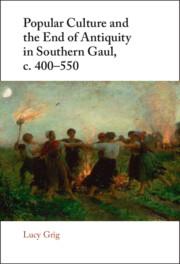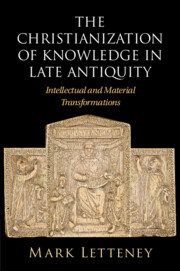14 results
Et de lupis grex fecundus multiplicatur agnorum. Le paysage ecclésiastique de la Byzacène méridionale et de la Tripolitaine occidentale
-
- Journal:
- Libyan Studies / Volume 55 / November 2024
- Published online by Cambridge University Press:
- 19 March 2025, pp. 150-162
- Print publication:
- November 2024
-
- Article
-
- You have access
- Open access
- HTML
- Export citation
7 - Sex in Iceland in the Fourteenth and Fifteenth Centuries ce
-
-
- Book:
- The Cambridge World History of Sexualities
- Published online:
- 26 April 2024
- Print publication:
- 16 May 2024, pp 132-149
-
- Chapter
- Export citation
Chapter 3 - Popular Culture, Society and Economy
-
- Book:
- Popular Culture and the End of Antiquity in Southern Gaul, c. 400–550
- Published online:
- 15 March 2024
- Print publication:
- 28 March 2024, pp 73-109
-
- Chapter
- Export citation

Popular Culture and the End of Antiquity in Southern Gaul, c. 400–550
-
- Published online:
- 15 March 2024
- Print publication:
- 28 March 2024
14 - Conversion and Literature
- from Part IV - The New Christian World
-
-
- Book:
- The Cambridge History of Old Norse-Icelandic Literature
- Published online:
- 08 February 2024
- Print publication:
- 29 February 2024, pp 291-312
-
- Chapter
- Export citation

The Christianization of Knowledge in Late Antiquity
- Intellectual and Material Transformations
-
- Published online:
- 28 September 2023
- Print publication:
- 12 October 2023
-
- Book
-
- You have access
- Open access
- Export citation
Conclusion
-
- Book:
- Biblical Heroes and Classical Culture in Christian Late Antiquity
- Published online:
- 10 November 2022
- Print publication:
- 24 November 2022, pp 318-326
-
- Chapter
- Export citation
6 - Christianizing the Roman Empire
- from Part I - The Classical Period
-
-
- Book:
- The Cambridge Companion to Antisemitism
- Published online:
- 05 May 2022
- Print publication:
- 02 June 2022, pp 100-117
-
- Chapter
- Export citation
2 - Early Medieval Canon Law
- from Part I - The History of Medieval Canon Law
-
-
- Book:
- The Cambridge History of Medieval Canon Law
- Published online:
- 13 January 2022
- Print publication:
- 27 January 2022, pp 32-45
-
- Chapter
- Export citation
Chapter 1 - Meeting the Alloglottic Other: The Socio-Linguistic Landscape of the Ancient Mediterranean and the Spread of Christianity
-
- Book:
- The Slow Fall of Babel
- Published online:
- 02 December 2021
- Print publication:
- 09 December 2021, pp 18-52
-
- Chapter
- Export citation
Chapter 1 - Liturgy and History in Early Rus
-
- Book:
- The Liturgical Past in Byzantium and Early Rus
- Published online:
- 09 August 2019
- Print publication:
- 15 August 2019, pp 15-34
-
- Chapter
- Export citation
On Christianization and Grave-Finds
-
- Journal:
- European Journal of Archaeology / Volume 2 / Issue 1 / 1999
- Published online by Cambridge University Press:
- 25 January 2017, pp. 77-106
-
- Article
- Export citation
5 - The legal status of the Jews in the Roman Empire
-
-
- Book:
- The Cambridge History of Judaism
- Published online:
- 28 March 2008
- Print publication:
- 22 June 2006, pp 128-173
-
- Chapter
- Export citation
21 - Christianization and religious conflict
- from PART V - Religion
-
-
- Book:
- The Cambridge Ancient History
- Published online:
- 28 March 2008
- Print publication:
- 11 December 1997, pp 632-664
-
- Chapter
- Export citation


